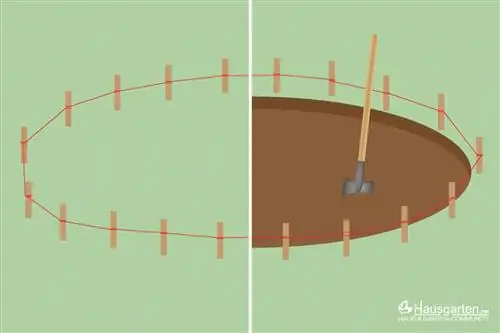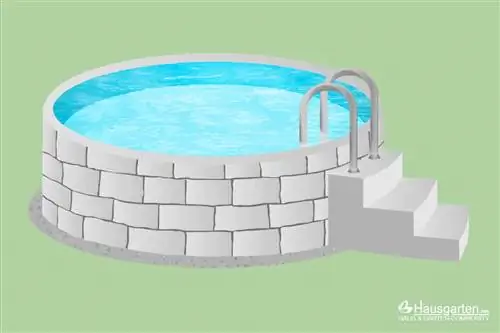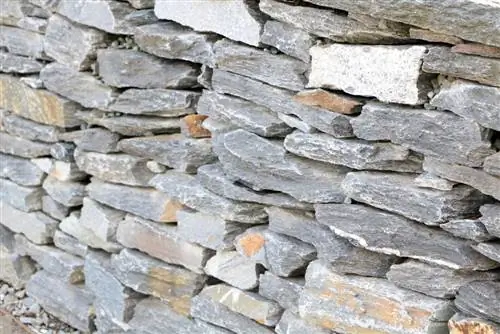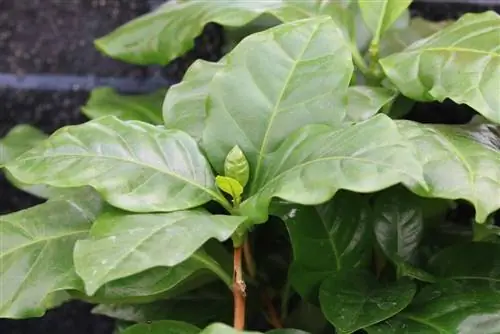- Author admin [email protected].
- Public 2023-12-17 03:39.
- Last modified 2025-06-01 06:48.
Setting up a pool on a slope is not impossible, but it does involve some effort. Therefore, you must pay close attention to the requirements when investing.
Dangers and disadvantages
A pool that sits on a slope is exposed to various hazards. These include:
- Tilt
- Water leakage
- Deformation of the pelvis
- uncomfortable walking in the pool
Accordingly, a flat surface must be created. However, this is also possible with a steeper gradient in the garden.
Slope for pools
The surface of a swimming pool should not have a gradient greater than one percent. This means that there can only be a difference of one centimeter per meter in length.
If there are major bumps or slopes, compensation must be made. The swimming pool should be on a surface that is as flat as possible to prevent problems. The following step by step instructions show how it can work.
Paving slopes - instructions

So that a pool can be set up despite unevenness, various steps are required. These may vary slightly depending on local conditions and may need to be adjusted.
Dig the foundation
Instead of leveling the entire garden, you can simply dig a foundation to create a level surface for the swimming pool. The following steps show how to do it:
Measuring and staking
The base area for the pool is measured and marked out. A thread can be stretched between the struts to serve as orientation.
Excavate
For small pools and small gradients, a spade is usually sufficient. For larger areas or large differences in height, a mini excavator should be used. This also makes sense on steeper gradients, as more earth has to be removed.
Cleaning
Foreign bodies such as roots and stones should be removed. Otherwise they can represent disruptive factors.
Leveling and compacting
Once a smooth surface has been created, the soil must be compacted and checked again. A vibrating plate or a flat vibrator, for example, can help here. For smaller areas, it may also be sufficient to lay down boards or slabs and weigh them down or walk on them or jump on them several times.
Note:
A mini excavator, like a flat vibrator, can be rented inexpensively from a hardware store. It makes work easier and therefore reduces the overall effort.
Fill
After compacting, equal parts of gravel, gravel and quartz sand can be filled into the foundation. On the one hand, this ensures that any overflowing water can drain away better. On the other hand, it compensates for any unevenness and gradients that may still be present. So that the filling is even, it should also be compacted.

If you want a more durable substructure, you can either lay out paving slabs, use Styrodur panels or concrete the foundation. However, concreting is only recommended if the property is owned. If the garden is rented or leased, you must first ask the owner.
Frame
Experience has shown that if there is a very steep gradient, it makes sense to set up a frame. This prevents, among other things, earth from slipping down and the pool from deforming or shifting. This represents a major risk, especially if there is frequent rain, few plants or very loose soil.
Possibilities for creating a frame or fastening include:
- Stone Wall
- Gabions
- Planting
- concrete lawn edging stones
But a solid wooden frame on the pool itself can also act as protection. A firmer frame is recommended for both inflatable and variants with a plastic frame.
Another advantage of this is that the frame can be used as a shelf or as a seat, for example. This opens up numerous design options. A gradual construction as a bench or with plants as a decorative backdrop - whatever you like is allowed.
Tip:
Since the frame may have to withstand a lot of weight, it should be set in concrete and made of stable materials. However, for rented properties, you must first obtain the owner's permission.






